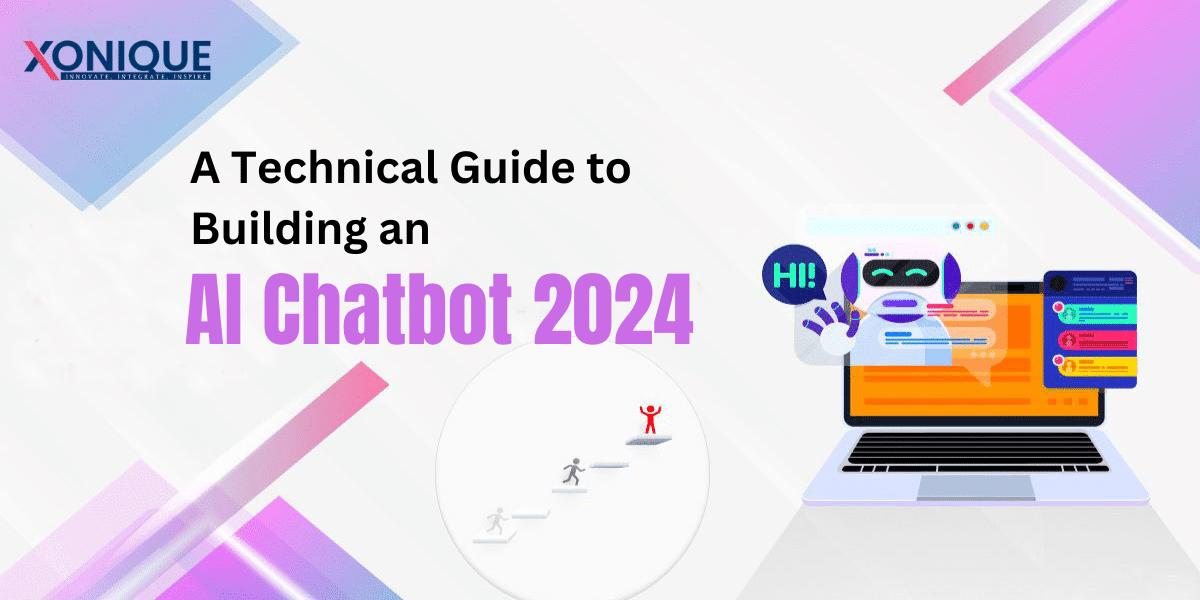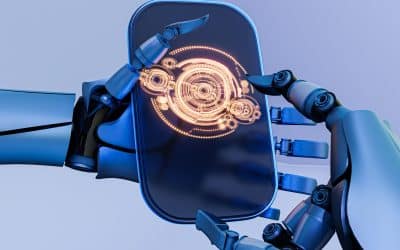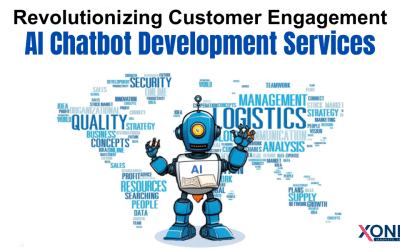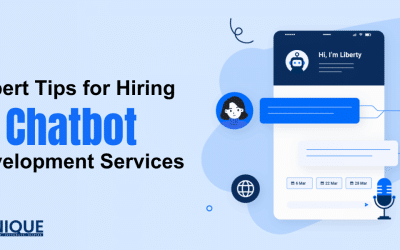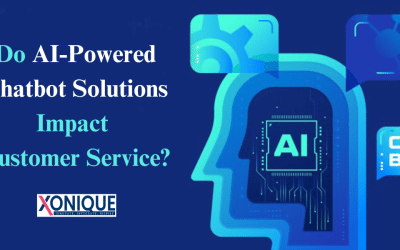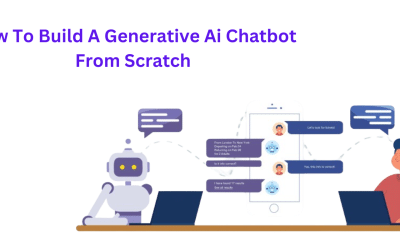With the advent of digital revolutions and instant communications, companies are always looking for ways to streamline their processes and boost the growth of their business. One tool that is becoming a game-changer can be described as AI Chatbot. However, why choose off-the-shelf tools when you can create an individual solution tailored to your business’s specific needs? If you’ve ever considered building your personal AI chatbot, you’re at the right spot.
Technology continues to develop astoundingly, and AI chatbots have quickly become indispensable in all fields. They are designed to recognize and answer human questions by providing immediate and individualized help. 2024 will mark a significant change in how businesses interact and collaborate. In the middle of this change are AI chatbots that transcend conventional text-based conversations to provide high-quality, contextually sensitive personal user experiences.
The widespread use of chatbots across many sectors indicates a significant shift in customer relationships and operating methods. Chatbots’ market, mirroring the trend, is predicted to experience massive growth forecasts, suggesting a 22.5 percent increase from 2020 until 2027. This will amount to a staggering $1,953.3 million. The growth in chatbots is a testament to their essential role in various sectors, indicating a significant shift in customer service and operating methods.
In this guide, we will discuss how to build an AI chatbot that simplifies the process and ensures your chatbot works but thrives in the crowded digital world.
The Evolution Of Chatbots
Chatbots have progressed a great deal since they first came into existence. Beginning as basic bots based on rules that only responded to a few simple commands, they’ve evolved into advanced AI-powered virtual assistants that can have conversations that are natural to people. The evolution was fueled by advances in the field of natural speech processing (NLP) as well as machine learning algorithms.
Nowadays, chatbots can understand their context, discern intent, and offer personalized responses. They can answer complex questions, provide suggestions, and even mimic human conversations. Incorporating AI techniques, including deep and machine learning, has made chatbots into intelligent machines that constantly learn and grow through user interaction.
The rising need for immediate and personal customer service fuels AI Chatbot Development Services. Companies recognize that chatbots can provide 24/7 help, reduce response time, and boost customer service. Due to their ability to manage many conversations at once, chatbots are revolutionizing customer support and service departments across various industries. However, the adventure continues beyond this point. Future developments will offer even more exciting opportunities in AI chatbots.
Understanding AI Chatbots
Regarding the creation of chatbots, there are two significant varieties of AI chatbots: rule-based and machine learning. The rule-based chatbots are built on established rules and guidelines. They respond in a systematic method.
In contrast, chatbots based on machine learning can learn from user interactions. They enhance their efficiency and can adapt to changing situations. They are valuable devices that provide rapid and precise responses to queries and improve user experiences. A chatbot is required, and many ways of building an AI chatbot exist.
Businesses can benefit from this, as it translates into a new customer interaction method. Instead of providing generic answers, AI chatbots can navigate complicated conversations and make customers feel respected and valued. They’re a practical option for today’s businesses, aiding in streamlining customer interaction, collecting data, and increasing overall service effectiveness. With the passage of 2024, chatbots will become a part of the arsenal of modern companies and are changing the way we think about digital customer support.
The Benefits Of AI Chatbots
AI chatbots have evolved from simple efficiency enhancements and have become pivotal devices for creating authentic customer experiences. They provide many advantages beyond cost savings and tap deep layers of engagement with customers and operational efficiency.
24/7 Availability
AI chatbots are never asleep. They’re available 24/7 and provide instant customer assistance anytime, from wherever. It ensures your company can be reached anytime, even during non-working hours.
Handling High-Volume Queries
The modern business landscape is extremely fast-paced. AI chatbots are skilled at handling a large volume of customer interactions simultaneously. This capability significantly decreases waiting times and improves overall effectiveness, allowing human employees to focus on more complicated questions.
Improved Customer Service
AI chatbots can simultaneously handle most customers’ queries, reducing response time. They can respond immediately, provide personalized advice, and assist customers in buying. This results in a better customer experience.
Agents Empowered With Insightful Insights
AI chatbots do more than chatbots. They’re clever data collectors. In analyzing the interactions of customers, they provide invaluable information to humans. It also improves the standard of service to customers and assists in the process of making strategic decisions.
For example, if a client creates a billing problem, the AI chatbot first engages with the customer to gather preliminary data. When it recognizes the difficulty, it seamlessly forwards the request to a human representative, who now has the information needed to solve the issue swiftly.
Competitive Advantage
Implementing AI chatbots with the help of AI Chatbot Development Company could help your company gain an advantage. By offering exceptional customer service, personalized interaction, and immediate help, you can distinguish yourself from your competitors and attract and retain customers.
Seamless Integration Into Business Ecosystems
AI chatbots can seamlessly integrate with different business applications, including inventory management, CRM, and marketing. This streamlines processes and creates a seamless user experience.
Personalized customer experiences
One of the significant benefits that comes with AI chatbots is their capacity to customize conversations. Based on past conversations and data about customers, chatbots can personalize interactions, making every interaction specific and tailored to the particular customer.
Building Your Custom AI Chatbot: Step-by-Step
The decision to develop your personal AI chatbot might be daunting. However, breaking the process into steps can make it easier to follow and help ensure that the chatbot you build is efficient and productive. Let us guide you through the process.
Define Your Objectives
Define the objectives and goals of the chatbot you have created. Determine the tasks it can do and the benefits it can provide your clients. Knowing your audience’s requirements and wants will influence the design and function of your chatbot to ensure it fulfills your customers’ expectations and improves their experience. For breadth and depth of queries, your bot will be able to answer. Narrowing down your chatbot’s expertise will result in better and more precise responses.
Choose The Right Platform
Choose a chatbot development platform best suited to your business’s needs. Consider user-friendliness, capacity Integrations, support, and AI features like natural language processing and machine learning.
Setting Up Your Bot’s Initial Responses
If you want to build customized chatbots without starting from scratch, The ChatGPT API is a great solution. Integrating it into your application will give you access to one of the world’s most advanced language models. The API assists in creating first-time responses for bots that are contextually sensitive and humanlike. Whatever you’re using, whether ChatGPT API or another program, you must provide your bot with a wide range of possible answers. It will be able to handle an array of questions efficiently.
Integrate Into Backend Systems
Connect your chatbot to your existing systems, such as customer relationship management (CRM) software, e-commerce platforms, or knowledge databases. The integration will allow your chatbot to access relevant information and offer personalized answers. Through the use of AI and advanced languages, your chatbot can not only respond to queries but will also be able to learn and change, constantly improving the quality of responses.
Iterative Testing And Refinement
When your chatbot is installed, the initial test in a controlled setting could help pinpoint glaring problems or areas that could be improved. It is inviting users to give feedback. It will provide insight into what’s working and which requires improvement. Based on real-time feedback and the chatbot’s experience, it constantly improves its algorithm and response database so that the chatbot’s effectiveness and relevance.
Launch And Monitor
When you’re satisfied with the chatbot’s capabilities, it’s time to go live. Track its actions, accumulate statistics, and implement changes based on data that will improve the effectiveness of your chatbot over time.
Following these steps, you can build an AI chatbot that fulfills your organization’s needs and delivers users a smooth and enjoyable experience. Creating an efficient chatbot is more than just the technical aspect.
Best Practices For Designing An Effective AI Chatbot
Creating a successful AI chatbot requires carefully assessing the technical and user experiences. These are the top practices to keep on your radar:
- Create your chatbot with an authentic and casual tone. Do not use jargon that is complex or excessively formal terminology. Utilize short sentences to break complicated information down into digestible pieces.
- The chatbot you choose must provide instructions for what to do with it. Use prompts and buttons that provide users with guidance and assist them in knowing what actions they could perform.
- Offer users a range of responses that they can choose among. It helps them feel more involved and more in charge of the discussion. Be sure to ensure that all options offered are valuable and relevant.
- Use visual elements, like buttons, images, or videos, to improve the user experience. The visual cues you provide can make your interactions easier to comprehend and more engaging.
- Make use of user data to tailor the chatbot’s response. Namely, address users who recommend services or products according to their interests and customize the chatbot’s responses for their needs.
- Though chatbots are created to answer most questions, there will be times when human involvement is needed. Check that your chatbot can forward questions to an agent whenever required.
- Analyze user interactions regularly and feedback, identifying the areas that need improvements. Please use data-driven insights to enhance the chatbot’s response, conversation flows, and overall effectiveness.
Following these guidelines, you can develop an AI chatbot that offers accurate and efficient answers and participates in meaningful dialogue. The process of integrating the chatbot into the existing systems is an additional factor to be considered.
Which Is The Best AI Chatbot For Your Company?
Selecting the best AI chatbot to run your company is an important decision that can impact the customer experience and performance. To make the right choice, be sure to follow these actions:
Determine Your Goal
Get started by clarifying your business objectives. What issues do you intend to tackle with the help of an AI chatbot? The possibilities range from improving customer care, increasing lead generation, or simplifying your internal workflow. Understanding your goals will assist in selecting a chatbot that best meets them.
Review Your Requirements
Consider what your company needs specifically for chatbots. Consider aspects like the capabilities of natural language processing, integration with other systems scaling, and customization opportunities. By conducting an in-depth analysis, this analysis can assist in the identification of critical features that make up your particular business environment.
Do Your Research On The Market
Do some market research and look into the various AI chatbot companies. Choose vendors with an established reputation, favorable customer reviews, and a track record of successful deployments. Do not limit your search to specific niches. Broad-spectrum alternatives also provide valuable features.
Review AI Capabilities
Be sure to scrutinize the AI abilities of the platforms you’re contemplating. Advanced NLP, machine learning efficiency, and adaptive learning abilities are essential to ensure precise understanding and relevant interactions. A solid AI base is critical to the effectiveness of chatbots.
Options For Integration
Examine how well your chatbot can integrate into your digital environment. A seamless integration with CRM software, such as databases and APIs, is crucial for the chatbot to gain access to the necessary information and function optimally.
Personalization And Customization
Being able to modify and customize the experience of chatbots is vital. You must be able to change responses, layout, and chat flow to reflect your branding and satisfy users’ specific requirements.
Flexibility And Scale
Ensure that the chatbot platform can adapt to the ever-growing demands of users and the future growth of your business. Flexible and scalable, it can be easily deployed across various ways and continues to improve.
Experience Of The User And Interface
Choose a chatbot with a great user experience and a friendly interface. Navigation ease and easy layout are crucial for your clients and the staff who manage the chatbot.
Maintenance And Support
Check out the vendor’s support program. Support for customer service is available. Complete documentation, learning resources, and regularly scheduled updates are essential for ongoing help and improving your chatbot.
Analysis Of Cost And ROI
Also, consider the cost of the chatbot against likely returns on investment. Consider the costs of implementation and upkeep against the value that the chatbot can bring to your business through the effectiveness of your business and its customer interaction.
When you step towards analyzing these aspects and aligning them to your business’s needs, you can select the AI chatbot that will meet your immediate needs. And help position your company to grow and succeed.
The Impact Of AI Chatbots On The Future Landscape Of Business
AI chatbots have gained a significant foothold in a variety of fields, and their power will only increase:
Customer Service Revolution
There is no longer a need for businesses to be restricted by work hours or time zones. AI chatbots provide 24/7 help, answering queries and providing real-time answers.
Cost Efficiency
You must make a small initial investment when creating your personal AI chatbot. The longer-term benefits are reduced costs of the workforce and improved efficiency, which leads to a higher return on investment.
Data-Driven Insight
Each interaction through an AI chatbot gives businesses valid user data that can be used to make better business-related decisions.
Personalized Marketing
AI chatbots can personalize users’ experiences based on previous interactions. It will ensure that marketing campaigns are targeted and efficient.
Future Trends And Predictions For AI Chatbots
While AI chatbot technology advances, many intriguing trends and forecasts are developing. These are the developments to keep an eye on:
Rise Of Conversational AI Chatbot Development Services
Chatbots are expected to become more human and conversational due to natural language processing and sentiment analysis advances. Chatbots can recognize emotions, participate in conversation, and offer empathy-based responses.
Voice-Activated Chatbots
As voice-controlled assistants like Amazon Alexa and Google Assistant become more prevalent, Chatbots are increasingly connected to these voice-activated devices. The users can converse with chatbots through spoken commands, making chats more natural and easy.
Omnichannel Chatbots
Chatbots will seamlessly integrate through multiple channels, such as websites and social media platforms: chat apps and voice assistants. An omnichannel approach can provide an identical and personal user experience across all contact points.
AI chatbots will utilize user data and machine learning algorithms to deliver highly tailored, contextually aware responses. Chatbots can recognize individual preferences, anticipate the user’s requirements, and give specific advice.
Sum Up
AI chatbots can be used to transform customer assistance and customer service. Leveraging the latest advances in AI and NLP can enable businesses to provide immediate and customized customer experiences for customers. This will increase customer happiness and retention. The development of chatbots has been essential for companies that have transformed customer service and the efficiency of operations. They can recognize and respond to user queries with a humanlike approach, significantly improving customer experiences. The process of creating an AI chatbot is a process that requires meticulous pre-processing of data, choosing the appropriate platform, and connecting external APIs to enhance capabilities.
Continuous testing and constant improvements based on user feedback are crucial before deployment. Regular maintenance and updates will ensure your chatbot’s relevance and function in the long run. Since AI is constantly evolving and expanding, the possibilities for chatbot applications are endless. Take advantage of this revolutionary technology and start creating AI chatbots to revolutionize your company and open up opportunities.

